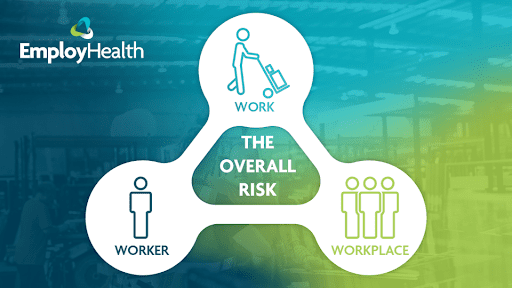What is the most common work related injury, and why does it matter?

According to the most recent data by SafeWork Australia, the most common type of work related injury is musculoskeletal disorders (MSD). MSD’s are injuries like sprains and strains that are typically associated with manual work tasks. Pain and discomfort can arise from a traumatic incident such as a slip or trip, or gradually over time from repetitive loading.
In 2021, 88% of serious claims were for injuries and musculoskeletal disorders. 40% of these claims were joint, ligament, muscle and tendon injuries (Data and Research – Work-Related Injuries, n.d.)
With MSD’s contributing to such a large percentage of work related injuries, it’s essential that no stone is left unturned when it comes to prevention. A proactive workplace health program that incorporates onsite physiotherapy provides the most innovative and leading methodology to achieve injury reduction in this area.

How does an onsite physiotherapy program prevent work related musculoskeletal disorders?
Employ Health’s onsite program employs a multifactorial approach, looking at integrating risk management strategies in 3 levels: the Work, the Worker and the Workplace.
The Work:
Having an extensive knowledge base of the physical job requirements and manual task risk is a crucial foundation for a successful program. In the initial stages, consultants extensively analyse every job within your workplace to develop an online Job Dictionary database. Each job is then assigned a physical rating from ‘sedentary’ to ‘very heavy’ manual work based using the standardised Dictionary of Occupational Titles (this a crucial requirement for the Capacity Matching System which will be elaborated on later). With the Job Dictionary complete, Manual Task Risk Assessments are conducted for tasks within each role. A report is then compiled with control recommendations for tasks with identified manual risk, which a site can then take action to make the task in question safer and easier.
The Worker:
A strong body of evidence suggests that the quicker a worker’s complaint is addressed with correct management and advice, the better the return to work outcome. (arpa.org.au, n.d., 1-3) Employ Health’s onsite service ensures Early Intervention injury management is easily accessible to the worker by providing an experienced physiotherapist on your doorstep. A 24/7 Rapid Response service is also available to allow phone injury triage, should a complaint arise outside of onsite hours. During a consultation the worker’s complaint will be assessed by one of Employ Health’s workplace physiotherapists who are elite performers in the occupational rehabilitation of workplace musculoskeletal disorders. If required, the physiotherapist can use our job database to provide accurate modified duties recommendation to prevent aggravation and escalation of work related injury. As part of an assessment, the worker’s physical capacity can also be assessed and subsequent physical rating assigned to them, which can subsequently be matched to their job’s physical rating. In the case of a mismatch, the worker can participate in a Prehab strength and conditioning program to get fitter and stronger BEFORE an injury happens.
The Workplace:
Regular initiatives to drive an emphasis that ‘Health Trumps Everything’ will transform a workplace’s culture. The fitter and healthier workers generally are, the lower the likelihood of injury. A variety of training sessions are provided, including supervisor training, to facilitate correct injury management protocols and optimal worker support. Specific ergonomic training for both office based and manual work can also be provided.
Once the core foundations of the program are established, there are many proactive initiatives which can further emphasise the importance of health across the workplace and reduce the risk of injuries. For example, personalised Fit For Life assessments can be conducted with workers for a variety of objective health and wellbeing measurements, including body mass index (BMI), blood pressure, diabetes risk, dietary habits, sleep hygiene, emotional wellbeing and physical activity levels. Workers are then educated on areas of improvement and goals set to change lifestyle factors as required. Depersonalised data can also be captured to provide an insight on the overhealth health and wellbeing status of your workplace. This data can then be utilised to initiate further wellbeing initiatives such as targeted Health and Wellbeing Seminars.
In summary, the safety of your workers should be the number one priority in any workplace. Work related injuries have a detrimental effect on all reaches of an organisation. MSD’s are the most common workplace injury, so having effective management strategies in place are essential. Employ Health’s workplace physiotherapists are best placed to assess, manage and mitigate musculoskeletal injury risk. The unique multifactorial approach of an onsite program removes crucial access barriers and uses data-driven initiatives to promote health as the key cultural driver of change, with outstanding results.
This brief overview only really scratches the surface of the types of onsite services that can help prevent the most common injuries in your workplace. If you would like to find out more about what Employ Health can offer and how we can meet the specific needs of your workplace, please get in contact today.
References
-
arpa.org.au. (n.d.). The importance of early intervention and referral to workplace rehabilitation. Australian Rehabilitation Providers Association, (February 2021), 1-3.
-
Data and research – Work-related injuries. (n.d.). Safe Work Australia. Retrieved November 18, 2022, from https://www.safeworkaustralia.gov.au/data-and-research/work-related-injuries
